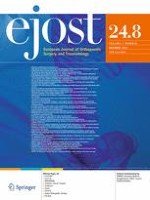01-12-2014 | Original Article
Functional evaluation in cruciate-retaining-type TKA: anatomical relationship between tibial osteotomy level and PCL attachment
Published in: European Journal of Orthopaedic Surgery & Traumatology | Issue 8/2014
Login to get accessAbstract
Introduction
The level and morphology of posterior cruciate ligament (PCL) attachment vary greatly among individuals, and the function of the PCL after tibial osteotomy performed during total knee arthroplasty (TKA) surgery remains unclear. Therefore, we evaluated the resection amount of PCL attachment and the function of the residual PCL in cruciate-retaining (CR)-type TKA.
Methods
We examined 76 patients with knee osteoarthritis who had undergone CR-type TKA. The level of the tibial PCL attachment was measured by preoperative MRI and the amount resected into the tibial PCL attachment from the osteotomy level as well as the longitudinal diameter of the residual PCL by postoperative radiography. The relationships between these and joint gap tension value at flexion or amount of tibial posterior transfer by postoperative stress radiography were examined.
Results
The longitudinal diameter of the PCL attachment and the attachment level varied widely among patients. There were 39 patients (51 %) with tibial osteotomy level caudal to the PCL attachment. Flexion gap tension in patients with residual PCL (residual PCL group) was slightly higher than those without residual PCL (fully-resected group). There was no correlation between amount of PCL residual and joint gap tension at the flexion position. Even in those without residual PCL, no correlation was observed between the resected amount and flexion joint gap tension value. Comparison of amount of posterior transfer by postoperative stress radiography between those with and without residual PCL revealed no significant difference.
Conclusions
It was confirmed that the level and morphology of the PCL attachment vary greatly among individuals and the amount of PCL resected at tibial osteotomy during TKA surgery varies depending on the patient. The tension due to flexion position tended to decrease if the tibial osteotomy line was caudal to the PCL attachment; however, the amount of tibial posterior transfer due to stress was not changed.





